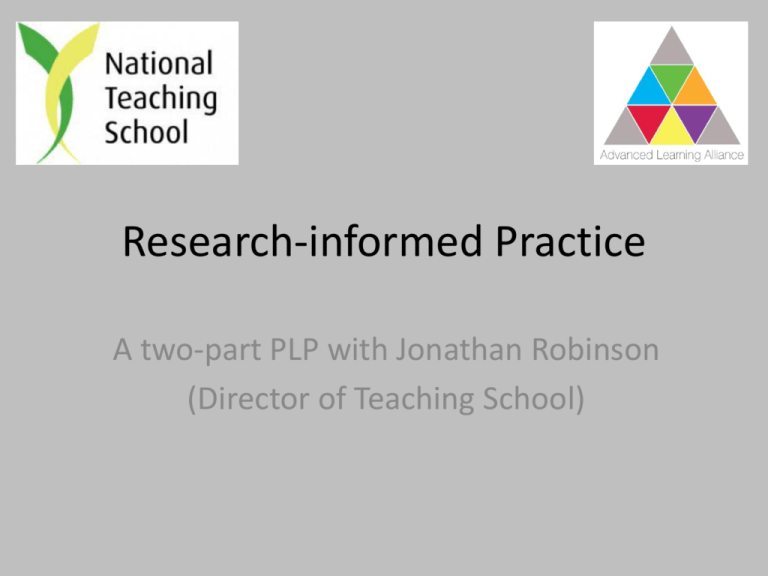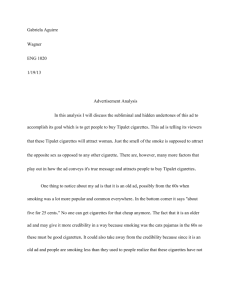Research-informed Practice - Advanced Learning Alliance
advertisement

Research-informed Practice A two-part PLP with Jonathan Robinson (Director of Teaching School) Part I • • • • Lifeworthy Learning Flipped Learning Forgetful Learning Retrieval Learning 2 Lifeworthy Learning 3 State something you understand really well How did you come to understand it? How do you know you understand it? 4 5 The Top Results from the International Conference on Thinking (2007, Sweden) • • • • • • • • • Thinking Self-understanding Empathy Ethics Communication Learning to learn Environment Global perspectives The arts • • • • • • • • Collaboration Health Dealing with conflict Spirituality Science Maths Technology Society and how it works 6 The Problem with Achieving Literacy READING LITERACY + KNOWLEDGE 7 What is worth Learning? Choice of What to Learn 21st Century Skills Beyond Traditional Disciplines Interdisciplin Global ary Perspectives Problems Learning to Think about the World with the Content 8 Knowledge as Vehicles INSIGHT: HOW DOES THIS MAKE SENSE OF THE WORLD WE LIVE IN? ETHICS: WHAT CHOICES AND MORAL DILEMMAS RESULT FROM ACTION? ACTION: HOW CAN WE ACT EFFECTIVELY IN THE WORLD AS A RESULT OF INSIGHT? OPPORTUNITY: HOW DOES ALL THIS LEARNING 9 MATTER TO LIVES OF LEARNERS TOMORROW? Tim Holt: Big Questions (from Think historically: narrative, imagination, and understanding (1990) Take a page from a text book, look at the assertions made (declarative statements). Challenge the statements by creating questions from them or about them (interrogatives). 10 Cross-Disciplinary Buckets Poverty Latin American geography, socioeconomic history, geopolitics, political systems, sociology, applied sciences, religions and faith, literature, media studies, music, design and technology, art, textiles, food, sport, the Law, tourism, business and economics … 11 What’s the point of [Spanish]? • • • • • • • • • • • • • A is for … Al-Andalus B is for … bullfighting C is for … conquest D is for … dictatorship E is for … ecology F is for … film G is for … Gaudí H is for … humanity I is for … independence J is for … Judaism K is for … kingship L is for … literature M is for … modernism • • • • • • • • • • • • • N is for … nutrition O is for … Opus Dei P is for … Picasso Q is for … Quixote R is for … Romance S is for … sport T is for … terrorism U is for … universe V is for … voyages W is for … the West X is for … xenophobia Y is for … Yucatán Z is for … zarzuela 12 13 14 Flipped Learning 15 DEVELOP TWIRLS! T = THINK W = WRITE I = INTERACT R = READ L = LISTEN S = SPEAK The Ideal Educational Landscape Content FLIPPING FORMATIVE ASSESSMENT Curiosity 16 Relationship Forget to Learn: 5 Little Ideas • Study Use Reinforce • Performance Manner of Study • Silent Study (no stimulus) + Silent test (no stimulus) Low Retrieval • Interference during learning promotes forgetting forces deeper concentration • Restlessness can be a sign of concentration 17 Change Habits of Learning • Add colours and sounds to words (combine visual stimulus with cognitive activity) • Change where we study • Change how we study (standing, moving, sitting …) • Re-writing not revising • Sit pre-test to purposely fail. That leads to strengthened learning later on. (Set end of unit test on the first lesson and then again at the end of the unit) • Self-testing regularly • Interleaving (e.g. practise several skills at once) • Mix problem types in homework, so students have to draw from prior and current learning and adapt to new contexts 18 Spaced Learning of Factual Information aka Distributed Study Time Time to the Test First Study Interval 1 week 1 month 3 months 6 months 1 year 1-2 days 1 week 2 weeks 3 weeks 1 month 19 Interruption 20 Retrieval Learning 1. 2. 3. 4. 5. 6. 7. 8. 9. 10. 11. 12. 13. 14. 15. 16. Regular testing of the same material (aka calibration) Quizzes at the start and end of lessons Delay feedback and correction Regular self-testing rather than revising by rereading Interleaved practice Varied practice Relatable contexts for retrieval Foster conceptual cross-curricular learning Generation learning Writing to learn Student-led learning Learn through non-preferred learning styles Make stories out of learning Pre-reading and anticipate questions and possible answers Free recall plenaries Learning paragraphs 21 Leitner Boxes 22 Conceptual Learning 23 Memory Palaces 24 Reflection and Next Steps 25 Part II: Changing Landscapes • Variance Theory • Gamification of Learning Premack’s Three Criteria of Pedagogy (1984) 1. There is a goal for learning 2. There is a systematic attempt by the teacher to help the learner reach that goal 3. The systematic attempt is guided by the teacher’s perception of the learner’s progress “Pedagogy, in its widest sense, is the servant of cultural evolution.” - Ference Marton Challenge for Teaching Profession and Society at Large: a) Do we remove the institutionalism of ‘pedagogy’ somewhat and focus on connecting students with the ‘real world’? OR b) Do we enhance pedagogical function so students see the world more powerfully, where the school is seen as part of the real world? 26 Variance Theory • At least two variants are needed to enable meaning • Critical aspects are needed to enable learning and make students independent in their learning • Keep questions as open as possible 27 Example 1: learn to do or learn to see? 28 Example 2: What is the critical aspect? 29 Example 3: How to discern the first time? 30 Variation in Action 1. 2. 3. 4. X i v i v Y i i v v (repetition) (contrast: what’s different) (generalisation: what’s the same) (fusion: what’s different and same) Action: Prepare students for the unknown by means of the known – expose to lots of different angles on an issue and learn to discern different types of variation 31 Questioning Style a. Can an octopus change its colour? b. Can you name an animal that changes its colour? c. Why does the octopus change its colour? In (a) the fact is proposed and student only has to decide true or false. In (b) the fact is given and student has to remember what fits. But in (c) the fact is stated and the student has to explain 32 Question Style Continued • Try to avoid pointing out the relevant aspects of a problem to be solved, so students have to discern them. Example 4: “What makes a pendulum swing faster?” Example 5: “Three fishermen were spending the night on the riverbank. All were smokers, but only one had an open pack of cigarettes. They divided the cigarettes equally. By the morning each one had smoked 4 cigarettes, and they left altogether as many cigarettes as each one had had at first. How many cigarettes did each fisherman get when the cigarettes were divided equally?” • Then get students to construct their own similar problem based on what they have discerned 33 Example 6: Students Themselves Bring About the Variance Needed to Learn From Kafka’s Vor dem Gesetz (Morton & Booth, 1997, p.150): ‘The story concerns a man who tries to get admittance to the Law, the door to which is fiercely guarded by a man who refuses him entry, saying that he is not allowed in but that he should wait and see. However many times and in however many ways he tries to get in, he is unsuccessful. As the old man makes a final attempt, asking why nobody else has ever tried to go through the door, only to be told by the guard that the door was only for him, and now that his life was coming to an end, the door was to be closed.’ What did Kafka want to say with the story? 34 Finding Novel Meanings • Change points of view • Change the perspective for looking at a problem • Represent the task in different ways • Use different tools to handle a task • Ask ‘What if?’ questions • Juxtapose a problem with similar and different problems in order to understand it better 35 Example 7: Using Video to Shift Focus • Watch a scene without the sound and break the scene into segments • With each segment the students focus on one element and describe what they see in detail • Then play whole scene with students reading the script as a kind of voiceover • Then show students a similar scene with a different protagonist. Repeat the process. • What is different? Why? • Homework: Find another similar clip and watch with sound. What do you notice? How does this clip differ and bear resemblance to the first two clips? 36 Owning Learning 37 What do Students Learn? 1. Problem is invariant, but solutions variant – students learn that problems can have multiple solutions 2. Problem invariant, but context variant – students learn which solution is best for a given situation 3. Pattern invariant, but vary rotational position – students make idea of rotation their own 4. Pattern invariant, but vary reflections – students make idea of reflection their own 5. Pattern invariant, but vary descriptions – students learn how a set can be understood in terms of its elements or the transformations that generate it 38 Challenge 1: Mathematical • British education tends to employ the less effective approach of an invaried method but varied problems • A shift to more varied methods for teaching a common problem may be more effective (as shown in the Chinese approach to teaching mathematics: called 变式 (biànshì). 39 Challenge 2: Literary • British education tends to approach genre (and other literary or linguistic concepts) by looking at multiple examples of a given genre (or other literary / linguistic concept). • A more powerful approach to understanding a specific genre (etc.) may be to compare texts of different genres (or other concept) that all share the same theme, thus making the features of a given genre (etc.) more discernable. 40 Gamification – Why? • • • • • • • • • • It’s fun! It’s stimulating! It’s collaborative and competitive It promotes thinking It makes learners face up to the consequences of their decisions and actions It facilitates the transition of learning to the real world It acts as a catalyst for intrinsic motivation It makes progress extremely explicit It promotes a positive feeling of accomplishment while building resilience It develops tacit knowledge 41 Gamification – Basic Principles • • • • • • It should simulate reality It should consist of challenges It should develop social skills (and other soft skills) It should award points It should lead to rewards It should lead to mastery through completing successive challenges and from making mistakes in a safe environment • It should make active involvement compulsory • It should incorporate choice and personal responsibility 42 Reflection and Next Steps 43 Further Reading • Bergmann, J. and Sams, A. (2014) Flipped Learning – Gateway to Student Engagement, Washington D.C.: ISTE • Brown, P. C., Roediger III, H. l., and Mc Daniel, M. A., (2014), Make it Stick – The Science of Successful Learning, London: The Belknap Press • Carey, B., (2014), How We Learn – The Surprising Truth about When, Where and Why It Happens, London: Macmillan • Marton, F., (2014), Necessary Conditions of Learning, Oxford: Routledge • Perkins, D. N., (2014), Future Wise – Educating our Children for a Changing World, San Francisco: Jossey-Bass 44 Online Reading • eLearning Industry. Pappas, C. et al How Gamification Reshapes Learning (Free eBook) [online]. Accessed at: http://elearningindustry.com/howgamification-reshapes-learning#cover • [accessed 15 October 2014]. 45



